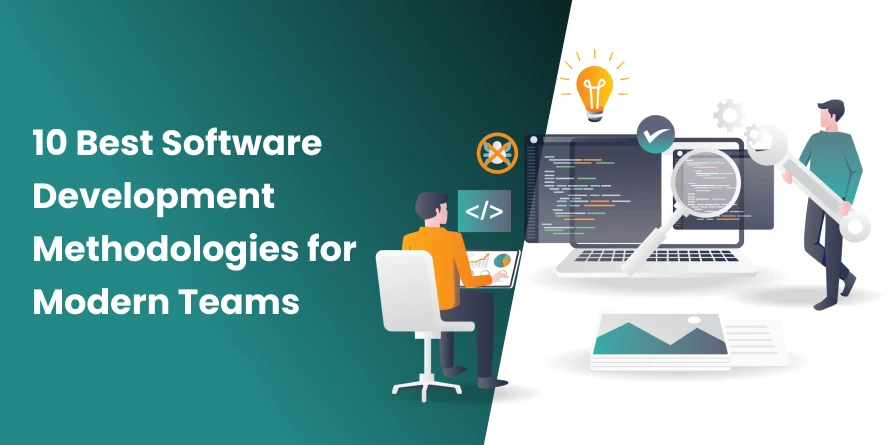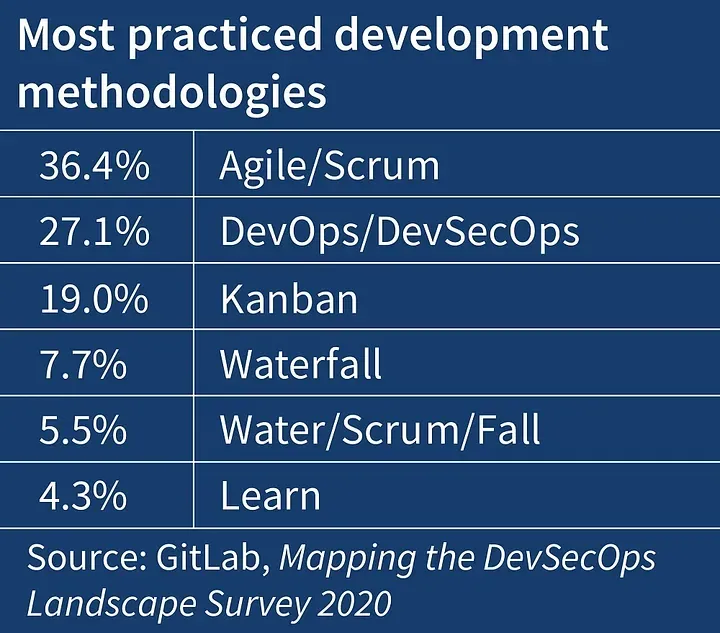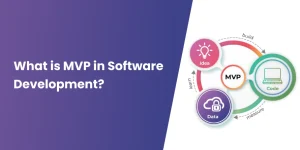10 Best Software Development Methodologies for Modern Teams

Successful software projects aren’t built overnight. It’s the result of planning, teamwork, and, importantly, the development methodology a team follows. Modern software teams face shifting requirements, remote and distributed work, condensed timelines, and continuously evolving tech stacks. Without the right process, quality, speed, and alignment suffer.
This article walks you through the 10 best software development methodologies used by modern teams, including Scrum, Kanban, DevOps, Lean, Waterfall, and Extreme Programming, explaining what they are, when to use them, and how to choose the one that gives your project structure without sacrificing adaptability.
Keep reading to match your team’s needs to the methodology that will set your next product up for success.
What is Software Development Methodology?
Simply put, a software development methodology is the step-by-step process teams use to plan, design, develop, test, and deliver software systems. It acts like a roadmap, defining how tasks are organized and executed to ensure projects are delivered on time and with high quality.

Source: Enlear Academy
As of 2024, Agile dominates, with nearly 86% of teams using Agile practices and Scrum being the most widely adopted framework. At the same time, DevOps is rising, with 69% of organizations embracing it to achieve faster, more reliable releases.
However, many enterprises don’t stick to just one approach. Instead, they blend methodologies. For example, mixing Agile’s flexibility with Waterfall’s structure to handle large, complex projects. This trend highlights a growing focus on customization and adaptability in modern software development.
Why Follow a Software Development Methodology?
In any software project, whether you’re building a small mobile app or a large enterprise platform can quickly become chaotic without a clear process. A development methodology provides structure, alignment, and predictability, ensuring teams and stakeholders work toward the same goals.
Following a methodology is essential because it:
- Reduced project risk by setting clear goals and checkpoints
- Improves team collaboration and communication
- Enables faster problem-solving through structured workflows
- Helps manage time, cost, and scope effectively
- Encourages consistent coding, testing, and deployment standards
- Supports adaptability to changing client or market needs
- Ensures better quality assurance and post-launch support
In the evolving software market, companies that follow a strong methodology are more likely to build scalable solutions, especially when they hire developers who are experienced in Agile, DevOps, or other frameworks.
Whether you’re outsourcing or doing in-house custom software development, choosing and adhering to the right methodology boosts both productivity and client satisfaction.
The 10 Most Common Software Development Methodologies
There are lots of different software development methodologies present, and each has something different to offer.
Here, we are going to list the ten most popular software development methodologies, each with its unique principles, strengths, and applicability.

Waterfall Software Development
The waterfall methodology is one of the earliest and most traditional approaches to software development. It follows a linear, sequential flow, where each phase must be completed before the next one begins.
The process typically involves stages such as requirements gathering, system design, implementation, testing, and maintenance. Changes are difficult to accommodate once a phase is completed, making it a rigid process.
Benefits
- Simple and easy to understand and manage due to its structured nature.
- Ideal for projects with clearly defined requirements that are unlikely to change.
- Provides a clear project timeline with specific deliverables at each stage.
Challenges
- Inflexible to changes during the development process.
- Risk of delaying testing and late discovery of defects since testing happens after the build phase.
- Poor adaptability is required in dynamic environments where requirements evolve frequently.
Agile Development Methodology
Agile is an iterative approach that emphasizes flexibility, collaboration, and customer feedback. Teams break down the project into smaller chunks or sprints, typically lasting between 2 to 4 weeks.
After each sprint, the product is reviewed, allowing the team to make adjustments based on client feedback, market conditions, or new insights. Agile is based on the Agile Manifesto, which values individuals and interactions, working software, customer collaboration, and responding to change.
Benefits
- Highly flexible, allowing changes at any point in the development cycle.
- Faster time-to-market with continuous delivery and iterative development.
- Promotes strong collaboration between cross-functional teams.
Challenges
- Requires a high level of team discipline and self-management
- The lack of upfront planning can result in misaligned stakeholder expectations.
Scrum Methodology
Scrum is a widely adopted Agile framework that structures work into fixed-length iterations called sprints, typically lasting two to four weeks. Each spring begins with a planning meeting, where the team selects tasks from a prioritized backlog and sets clear goals.
Daily stand-up meetings keep everyone aligned, and at the end of each sprint, the team reviews progress and reflects on improvements.
Scrum’s strength lies in its regular feedback loops and adaptability. For example, a development team building an eCommerce app can quickly pivot features based on user feedback after each sprint. Teams benefit from transparency, faster delivery of usable software, and the ability to respond to change.
However, Scrum can be challenging if team roles aren’t clearly defined or if stakeholders demand changes mid-sprint, potentially disrupting focus and momentum.
Pros
- Encourages frequent delivery and feedback
- Promotes transparency and accountability
- Adaptable to changing requirements
Cons
- It can be difficult for teams new to Agile principles
- Requires disciplined roles and ceremonies
- Not ideal for projects with fixed requirements
Extreme Programming (XP)
Extreme Programming (XP) is an Agile methodology that emphasizes technical excellence and customer satisfaction. XP practices include pair programming, test-driven deployment, frequent releases, and continuous integration. The philosophy is to embrace change-even late in the process- and to write clean, well-tested code.
A typical XP scenario might involve two developers working side-by-side, constantly reviewing each other’s code and writing automated tests before implementation. This results in fewer bugs and higher-quality software but demands a high level of collaboration and discipline.
Pros
- High code quality due to rigorous testing
- Rapid responses to changing requirements
- Continues customer involvement
Cons
- Can be resource-intensive (requires pair programming and frequent releases)
- May not scale well for large, distributed teams
- Require significant buy-in from both developers and customers
Lean Software Development
Lean Software development borrows principles from lean manufacturing, focusing on maximizing value while minimizing waste. The methodology encourages teams to eliminate anything that doesn’t add value, such as redundant features or excessive documentation.
Lean also promotes building quality from the start, empowering teams, and delivering fast by working in small, manageable increments.
For instance, a startup might use Lean to release a minimum viable product (MVP) software quickly, collect user feedback, and iteratively improve the product. Lean’s holistic approach can lead to faster time-to-market and higher customer satisfaction, but it requires a cultural shift and a commitment to continuous improvement.
Pros
- Increased efficiency and reduced waste
- Faster delivery and improved product quality
- Flexibility to adapt to real user feedback
Cons
- Implementation can be challenging and requires cultural change
- Risk of over-iteration, focusing too much on minor details
- Success heavily depends on team collaboration and discipline
Kanban
Kanban is a visual workflow management method that helps teams optimize their process and identify bottlenecks in real time. The core of Kanban is its board, divided into columns such as “To Do”, “In Progress”, and “Done”.
Tasks move across the board, providing transparency and immediate insights into project status.
Kanban doesn’t prescribe fixed iterations or roles, making it highly flexible. Teams can use it alone or alongside other methodologies. For example, a support team handling incoming bug reports might use Kanban to ensure issues are addressed promptly and nothing falls through the cracks.
Pros
- Visualize the workflow and highlight bottlenecks
- Highly flexible – no need for fixed sprints
- Encourages continues delivery
Cons
- Lack of timeboxing can lead to less predictability
- May not provide enough structure for some teams
- Overloaded boards can become difficult to manage
DevOps Software Development
DevOps is more than a methodology – it is a culture and set of practices that bridge the gap between development and operations teams. The goal is to automate and integrate the processes of software development, testing, deployment, and infrastructure management.
A DevOps approach might involve automated pipelines that test and deploy code to production several times a day, ensuring rapid delivery and quick feedback. This leads to faster releases and more reliable systems, but requires investment in automation tools and a collaborative mindset.
Pros
- Accelerate software delivery cycles
- Improves reliability through automation
- Breaks down silos between development and operations
Cons
- Implementation can be complex and require cultural change
- Upfront investment in tools and training
- Not all organizations are ready for the required level of collaboration
Rapid Application Development (RAD)
Rapid Application Development is all about speed. RAD prioritizes quick prototyping and iterative delivery over strict planning and documentation. Teams build functional prototypes, collect valuable feedback, and refine the product in short cycles.
This approach is ideal for projects where requirements are likely to evolve or when time-to-market is important. For example, a marketing team might use RAD to quickly launch a campaign app, test it with users, and make rapid adjustments.
Pros
- Fast development and delivery
- Higher user involvement and feedback
- Flexible to changing requirements
Cons
- Can lead to technical debt if quality is sacrificed for speed
- Not suitable for large, complex systems
- Requires active participation throughout the process
Prototype Development Methodology
This methodology emphasizes building an early working model of a software product to clarify requirements and collect feedback before full-scale development. Prototypes can be as simple as wireframes or as complex as functional modules.
This approach is particularly useful when requirements are unclear or innovative features need validation. For instance, a team designing a new user interface might create clickable prototypes to test usability with real users before investing in full development.
Pros
- Helps clarify requirements and reduce misunderstandings
- Early detection of design flaws
- Engage stakeholders and users throughout development
Cons
- Can lead to scope creep if prototypes are continually revised
- May increase initial development time
- Not always suitable for projects with well-defined requirements
Spiral Methodology
The Spiral Model is a risk-driven software development methodology that blends elements of both iterative and waterfall approaches. The Spiral Model organizes development into cycles—called “spirals”—with each spiral consisting of four key phases: planning, risk analysis, engineering, and evaluation.
During each cycle, the team begins by identifying requirements and objectives, then conducts a thorough risk analysis to uncover potential issues.
For example, a financial software company might use the Spiral Model to build a new transaction system, starting with a basic prototype, analyzing security risks, and refining the product through multiple cycles as new requirements and risks emerge.
Pros
- Excellent for managing and mitigating risks in complex or high-stakes projects.
- Allows for early identification of issues through iterative prototyping and evaluation.
- Flexible and adaptable, accommodating changes in requirements at any stage
Cons
- Can be resource-intensive and time-consuming, especially for smaller projects.
- Requires expertise in risk assessment and management.
Each of the above methodologies offers a unique approach to software development, catering to different team dynamics, project requirements, and business goals. The key is to assess your team’s needs and choose the methodology, or blend of methodologies, that best aligns with your objectives and culture.
How to Choose Which Methodology is Right For Your Team?
With so many software development methodologies available, choosing the right one for your team can feel overwhelming. Each approach offers unique strengths, but not every methodology will suit your project’s needs or your team’s working style.
To make an informed decision, it’s significant to weigh several technical and organizational factors that directly impact project success.
Project Requirements
Every methodology is designed to address specific project goals, such as reducing waste, increasing efficiency, or improving quality. Begin by evaluating your project’s unique needs, such as:
- What is the scope?
- How complex are the requirements?
- What are the critical success criteria?
For example, projects with rapidly changing requirements may benefit from Agile, while those needing strict compliance might lean toward Waterfall.
Team Size and Expertise
The composition and experience level of your team can determine which methodology will be the most effective. Larger teams may require structured approaches with clearly defined goals, such as Scrum, to maintain coordination.
Conversely, smaller or highly skilled teams might excel with Lean or Kanban, where autonomy and flexibility are prioritized.
Timeline and Budget Constraints
Time-to-market and budget limitations are often decisive. If you’re working under tight deadlines or with limited resources, methodologies like Rapid Application Development (RAD) or Lean can help accelerate delivery and control costs.
However, if predictability and detailed planning are priorities, a linear approach like Waterfall could simplify budget management.
Stakeholder Involvement
Consider how much and how often stakeholders need to be involved. Agile methodologies encourage frequent feedback and collaboration, making them suitable for projects where clients or end-users play an active role.
In contrast, methodologies with fewer review cycles, such as Waterfall, may be better for projects with less stakeholder interaction.
Project Complexity and Risk
Complex projects with many moving parts or high uncertainty often benefit from iterative, adaptive methodologies like Agile or XP, which allow for regular reassessment and course correction.
Simpler, well-defined projects may succeed with more traditional, sequential models.
Technological Landscape
The choice of technology and the novelty of the solution can also influence your decision. Projects leveraging cutting-edge or evolving technologies may require the flexibility of Agile or RAD to accommodate frequent changes.
Established technologies with clear implementation paths might fit well within structured methodologies.
Organizational Culture and Flexibility
Finally, the broader organizational environment plays a significant role. Agile and DevOps thrive in cultures that value collaboration, transparency, and continuous improvement. If your organization is more hierarchical or resistant to change, transitioning to these methodologies may require additional training and a gradual cultural shift.
By carefully assessing these factors, you can select a methodology that not only aligns with your project’s technical demands but also complements your team’s strengths and your organization’s way of working.
Which Software Development Methodology is Best?
There is no single “best” approach to building a custom software development project plan. Eventually, the choice depends on the specifics of your project.
Weigh factors like project size, complexity, requirement clarity, and team dynamics against the strengths and weaknesses of each methodology before choosing the “ONE”.
If you’re unsure where to start, we’re here to help. At Guru TechnoLabs, we not only guide businesses in choosing the right methodology but also deliver end-to-end custom software development services tailored to business goals.
Let’s build something great together, reach out to us to plan your next software project the right way.





















